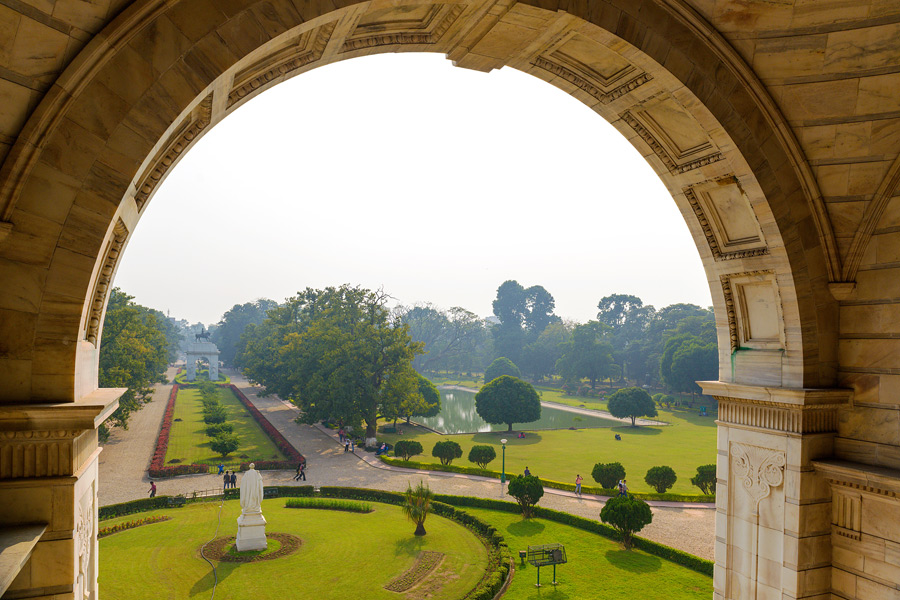[fshow photosetid=72157656716922645]
Travellers eager to experience the urban cool of Mumbai or the buzz of Delhi often overlook Kolkata and that’s a shame because the city has something for everyone, whether looking for culture, history, colonial-era architecture, bustling markets or tantalising cuisine.
Life around Sudder Street
The area around Sudder Street is a good entry point to the West Bengal capital – the streets are full of life and are considered the backpacker area of the city. Sudder Street itself is lined with hostels and guesthouses while the surrounding streets are full of restaurants and shops. During the day, street vendors line Lindsay Street, selling freshly squeezed lime juice, kati rolls (more on those later), freshly fried samosas and ghugni chaat, a typical Benghali street food made with yellow peas served piping hot with tomatoes, onions, coriander and a myriad of herbs.
Just a few blocks north of Sudder Street is the famous New Market, one of the busiest and most popular shopping districts in the city, visited by tourists and locals alike. The market has burned down a number of times and is prone to flooding but continues to be rebuilt – the name likely stems from that fact. It dates back to the mid-19th century, when the British bought the area around Lindsay Street to make a market reserved for Kolkata’s British residents and today stands as a remarkable Victorian Gothic complex, painted a bright red. Visitors can buy anything from food – the famous Nahoum & Sons confectioner was established here in 1902 – to sarees, kashmir shawls, crockery, crystal, furniture and clothing, amongst other things.
Kolkata’s Architectural Heritage
Not far from Sudder Street and New Market lies one of Kolkata’s most famous hotels, the luxurious Oberoi Grand Hotel, affectionately called The Grand Dame of Kolkata. The hotel dates back to the early 19th century and was built in an extravagant neoclassical style with colonnaded verandahs, stucco and balconies on the upper floors. The hotel is a nice respite from the heat and buzz outside and especially the afternoon tea service is popular with locals and tourists with money to spend.
The Victoria Memorial is another iconic landmark in Kolkata. Completed in 1921 in memory of Queen Victoria, it is now a museum that features a number of galleries as well as a collection of rare and antiquarian books, including illustrated works of William Shakespeare and Arabian Nights. The building itself, however, is the main attraction, built in white Makrana marble, using a mixture of British and Mughal architectural elements as well as Venetian, Egyptian and Islamic influences.
However, Kolkata is not just about grand colonial architecture and aristocratic mansions. Almost anywhere in the city, visitors can look up and see stunning, but derelict buildings, built for normal middle-class Bengalis. They commonly feature slatted windows, cornices, open rooftops and are painted in bright paint that are more often than not peeling, lending a certain nostalgia to the city.
Food Haven
For food lovers, Kolkata is a paradise. The city is not only known for its intellectual and cultural heritage, it was also one of the first in India to have a distinct culture of eating out. Like in all major Indian cities, street food dominate the food scene and it is impossible to walk 100 metres and not stumble upon a street vendor selling mishti doi, a fermented sweet yogurt made with milk, sugar and curd, or phuchka, a descendant of the pani puri, a small crispy shell filled with either a sweet or savoury concoction.
Perhaps the most famous street food in Kolkata is the kati roll. Many restaurants lay claims to its origin but many agree that is was New Market’s Nizam restaurant that came up with the idea of wrapping paratha, or Indian flatbread, around juicy pieces of kebab. Either way, it is one of the must haves when visiting Kolkata, the small pieces of either lamb or chicken kebab, or egg, accompanied by sliced onion, coriander, various kinds of sauces and perhaps some julienned vegetables. Delicious!
Another famous food institution in Kolkata is Kewpies, a hotspot for traditional West Bengali cuisine. The family owned restaurant is often featured in guidebooks and the mother has published a few cookbooks. The thalas are a must try – small feasts in themselves, they can contain up to ten dishes and are a perfect way to sample as many specialties as possible. The menu can be a bit hard to decipher for those with limited knowledge of West Bengali food but for those feeling a bit adventurous, why not ask the staff to bring out what they think is best?
Tips:
- Food in India has a reputation for not always being of the highest hygienic standards. To avoid spending a few days running to and from the toilet, try to pick places where many locals eat and use your common sense.
- Kolkata is a large metropolitan city and visitors will see poverty and conditions that are vastly different from that of western countries. It’s all part of the experience so come with an open mind.
- Kolkata is a cheap place to visit so make sure to tip the service providers you meet on your way. A small tip can go a long way.
- The area around Elgin road is home to some excellent bookshops and coffeeshops. Spend an afternoon browsing through the small lanes.

